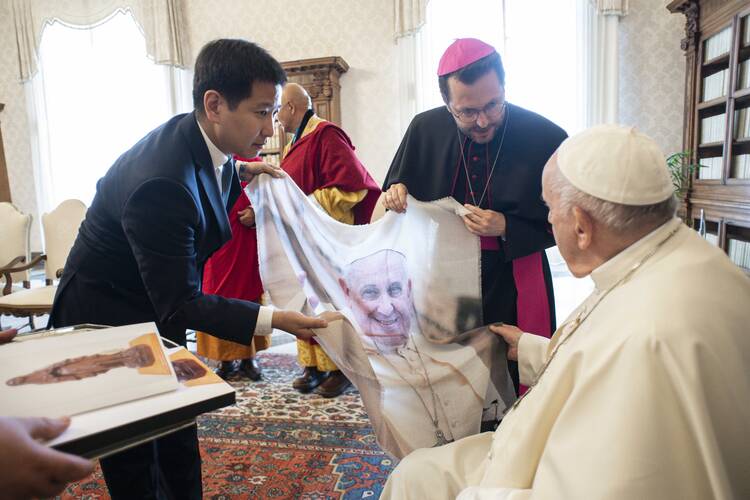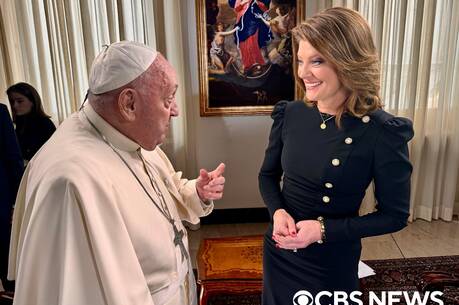While much of the world’s attention has focused in recent years on global superpowers Russia and China, the vast and sparsely-populated nation sandwiched between them, Mongolia, has often gone overlooked.
Once the seat of the mightiest land empire in history, Mongolia has a rich history and strong cultural identity rooted in Genghis Khan and the Mongol Empire. The Catholic Church in Mongolia, however, is young: Aside from a few missionary visitors in the Middle Ages, the church has only had a presence in Mongolia for about 30 years.
The Catholic Church in Mongolia is young: Aside from a few missionary visitors in the Middle Ages, the church has only had a presence in Mongolia for about 30 years.
Pope Francis will visit Mongolia’s 1,400 Catholics from Aug. 31 to Sept. 4, speaking to civil and religious leaders, including missionaries and participants at an ecumenical and interreligious gathering, and will dedicate a new House of Mercy, one of the charitable organizations that are often Mongolians’ first encounter with the Catholic Church.
Ahead of the pope’s visit, I spoke with missionaries and native Mongolians about the Catholic Church’s presence in the country. Despite the nation’s proximity to Russia and China, where Pope Francis has fought an uphill battle to influence the nations toward peace, religious freedom and respect for human rights, the people I spoke with do not see the pope’s mission as being related to Mongolia’s neighbors at all. Instead, they believe Pope Francis is continuing his mission of visiting nations that are often overlooked, with small Catholic minorities, in order to encourage them and draw the world’s attention to the difficulties they face.
A tradition of religious tolerance
“The Mongols are largely credited with being very tolerant of other religions,” Dr. Timothy May, Professor of Central Eurasian History at the University of North Georgia and an expert on the Mongol Empire, told me. “In reality, it was more of religious ambivalence. They believed in celestial insurance: Everyone prayed for the khan.”
The Mongol Empire reached its pinnacle in the 13th and 14th centuries, stretching from Eastern Europe and the Levant to the Sea of Japan, as far north as the Arctic and as far south as India. The Mongols, therefore, ruled over an enormous territory that encompassed many religions. Their policy of religious tolerance helped the empire live in peace.
“In many areas, when the Mongols did come in, they were often seen as liberators from religious oppression,” Dr. May explained.
While religions including Buddhism, Islam and Christianity made inroads in the Mongol Empire, the Mongols themselves were largely shamanistic, embracing a system of religious practice that continues today. Shamanism takes many forms, but it is generally characterized by visiting a shaman, a person who is believed to have a special connection to the spirit world and can use that connection to heal people.
Today, about half of Mongolians live in the capital city, Ulaanbaatar, with the rest spread thinly across the nation’s steppe.
After the Mongols invaded Europe in the 13th century, the first Catholics made their way to the steppe in what is now modern Mongolia. In the 1240s, Pope Innocent IV sent Franciscan friar John of Plano Carpini to visit the khan and invite him to become a Christian. Along the way, Dr. May said, he made records that he later presented to the pope.
“He had the makings of a great anthropologist in the level of detail he recorded,” Dr. May said. “He’s clearly a spy as well, because he is recording a lot of things about the military that you wouldn’t think a Franciscan friar would be very interested in.”
John of Plano Carpini returned to Innocent IV with a letter from Guyuk Khan demanding that the pope and the rulers of Europe come and submit to him. Popes generally avoided sending emissaries to Mongolia after that, and Christianity largely died out in the region when the Mongol Empire fell in the 14th century.
In the ensuing centuries, shamanism and Buddhism were the most commonly practiced religions in Mongolia, but the larger culture maintained its religious ambivalence.
After World War I, the country was briefly a Buddhist theocracy under the leadership of the Mongolian equivalent of the Dalai Lama, the Jebtsundamba Khutuktu. But after a Soviet-backed revolution in the early 1920s, Mongolia became the world’s second communist country, tolerating Buddhism for a few years before decimating the Buddhist population and initiating widespread purges of Buddhist monasteries.
From the 1930s until the collapse of the Soviet Union in 1991, Mongolia was officially atheist. The few who maintained a religious practice did so in secret. After religious restrictions were lifted, missionary groups from around the world flooded in. In some cases, the government even invited them, knowing the missionaries could help provide education and social services to the many Mongolians who had been left destitute following the transition to a market economy.
Today, about half of Mongolians live in the capital city, Ulaanbaatar, with the rest spread thinly across the nation’s steppe. It is the most sparsely populated country in the world. About 30 percent of the population is nomadic or semi-nomadic, living in portable yurts called geres, traditional circular Mongolian tents.
Despite the 70 or so years of theocracy followed by state-mandated atheism, the wider Mongolian culture returned to its longstanding tradition of religious tolerance after the fall of the Soviet Union. Today, the country enjoys total religious freedom, although non-religious people make up a sizable portion—40 percent—of the population. Around half of the population is Buddhist, and the remaining 10 percent are Muslims, Shamanists and Christians. Of the 60,000 or so Christians in the country, only about 1,400 are Catholic.
The Catholic Church is generally well-regarded in the country, particularly compared with other Christian groups. While most Mongolians’ first connection with Christians is through social services provided by the churches, some Christian groups require people to be baptized before they can receive assistance. The Catholic Church has no such requirement.
“It’s seen as a benign entity,” Dr. May explains, “whereas some other organizations have been certainly scrutinized as, you know, ‘What are they really up to?’”
The Catholic Church is generally well-regarded in Mongolia, particularly compared with other Christian groups.
A foreign faith
At the same time, there is some suspicion towards Catholicism and Christianity in general, as it is still seen as a Western religion. Many Mongolian Catholic converts are the only Catholics or Christians in their family. This often leads to tensions within families, or at least a lack of understanding.
The Rev. Peter Turrone, a former Consolata Missionary from Canada whose first assignment was to rural Mongolia from 2010 to 2013, shared the story of a young woman who got to know some Salesian missionaries by playing basketball with them. She eventually became interested in Catholicism and started to study Scripture with the brothers.
“Her father was very upset about this, and it created a lot of friction within the family for quite a while,” Father Turrone explained. “But then she ended up getting baptized, and I think it was her tenacity and the fact that she showed love and respect and patience for her family, particularly for her father, which kind of made things better over time. But again, there was a misunderstanding: This is something that is foreign, it’s something outside of who we are, and therefore it can be seen as a threat.”
At the same time, Father Turrone admits, Catholicism being perceived as Western can also be a draw for young Mongolians, who are in general interested in Western culture.
He explained that Catholicism’s “otherness” in Mongolia can paradoxically help Mongolian Catholics who feel isolated in their families to feel connected with a worldwide community.
Father Turrone said that his Mongolian parish had planned to build a grotto in honor of Our Lady of Consolation. His religious superiors met with Mongolian Catholics and asked them what they wanted the statue of Mary to look like. “The people said, ‘Well, what does Our Lady of Consolation look like in Italy? What’s the statue you have around the world?’ And we said, ‘Well, this is the statue.’ And they said, ‘Why can’t we have the same one?’”
The story points to a central lesson that Father Turrone has learned in his time as a missionary: The inculturation of Catholicism has to be led by the people, rather than the missionaries.
In his studies at the Pontifical Urban University in Rome, which trains missionaries, “we were made very sensitive to the different cultures and the necessity of recognizing that the Holy Spirit is already there,” he said. “We’re not there to impose a culture; we’re there to present a person. We’re there to present Jesus Christ. And it’s not the foreign missionary who is the one to inculturate the message, but it’s the people who receive the message. And that takes generations.”
Some inculturation, however, is already happening. Ten years ago, in Father Turrone’s mission, the central chapel was a gere. The cathedral in Ulaanbaatar, where Pope Francis will speak to bishops, priests, religious, missionaries and pastoral workers, is also built in the shape of a gere and contains images of a Mongolian Madonna and child.
Cardinal Marengo is currently traveling to every parish in Mongolia to spend four or five days there in order to encourage and get to know the communities.
Brother Andrew Tran, a Vietnamese Salesian of Don Bosco who works in a mission in Ulaanbaatar, is coordinating Pope Francis’ visit to the country. He was one of the missionaries invited by the Mongolian government to establish a technical school there in 2004. Today, in addition to working in his order’s finance office, he also helps to run an orphanage that houses 20 boys.
Over the last 19 years—almost two-thirds of Mongolia’s Catholic history—Brother Andrew has seen that Mongolians can often relate to the Gospel stories more easily than people from other places.
“The country of the Bible and the country of Mongolia are a little similar because of the nomadic [shepherds] in the steppe. The concept of being a good shepherd, to care for the sheep, people find it very similar to their daily practice,” he explained. Even though about half of Mongolians live in urban Ulaanbaatar, the image of a traditional Mongolian shepherd remains culturally important.
Likewise, it provides a connection point for a religion whose central message—of a God who suffers and is crucified—stands in contrast to the Mongolian cultural values of strength rooted in the legacy of Genghis Khan.
Cardinal Giorgio Marengo, apostolic prefect of Ulaanbaatar, in an interview with the YouTube channel Catholic Kazakhstan—another often-overlooked Central Asian country Pope Francis has visited—explained that during a discernment process the Mongolian Catholic community undertook last year, one need that emerged was “that we need really to be more and more rooted, to go deeper and deeper, into the society, so that our faith doesn’t seem something external or foreign.”
That takes not only time but active accompaniment, living closely with the people, getting to know them and walking with them on their faith journey.
For his part, Cardinal Marengo, the world’s youngest cardinal, is currently traveling to every parish in Mongolia to spend four or five days there in order to encourage and get to know the communities.
Likewise, the last 19 years have taught Brother Andrew to see his primary role as a missionary as one of accompaniment.
“The challenge for [Mongolian Catholics] is how to keep their faith, how to sustain their faith,” especially when they are the only Catholics in their family, Brother Andrew said. “And to [help] explain to a family member that being baptized, being Catholic, is not excluding other religions, but we live in harmony.”
Harmony with other religions is a hallmark of the church’s presence in Mongolia—and one that Pope Francis hopes to bolster.
'We live in harmony' with other religions
This harmony with other religions is a hallmark of the church’s presence in Mongolia—and one that Pope Francis hopes to bolster both with his trip and his appointment of Cardinal Marengo. The pope announced his elevation to cardinal when then-Bishop Marengo was visiting the Vatican with a delegation of Mongolian Buddhists.
Father Turrone, who lived in community with Cardinal Marengo, said he cried when he heard the announcement.
“Giorgio [Marengo] was like a brother to me, even though he was my religious superior. Giorgio is an incredibly humble man, and he’s very talented. His Mongolian is so perfect that people thought we were tricking them when they would meet him in person after having spoken to him over the phone,” Father Turrone said.
It is clear that Pope Francis sees Cardinal Marengo as an ideal missionary—one who is immersed in local language and culture, who works well with members of other religions while remaining rooted in his own in a way that is joyful, who draws others in and makes them curious about the source of his joy. It is a model the pope laid out in “Evangelii Gaudium” (“The Joy of the Gospel”), and one he hopes to encourage by reforming the church’s central structures to focus primarily on evangelization.
Pope Francis’ goal in visiting Mongolia will be not only to encourage the tiny Mongolian Catholic community, helping them feel connected to the universal church, but also to encourage the kind of interreligious dialogue that Cardinal Marengo has been undertaking and that the pope has emphasized in his many visits to Catholic-minority countries thus far. The pope will give a highly anticipated speech at an ecumenical and interreligious gathering in Ulaanbaatar on Sept. 3.
For Brother Andrew, the visit will not only be an encouragement toward dialogue and for the Mongolian Catholics but also for his own mission work.
“I feel a little empowered to be more confident as a missionary” now that the pope is visiting, he said. “Coming from a small country, before I got lost. Sometimes I feel shy to talk to people; I feel a little small in the crowd. Now, you see, the picture has been changed a little bit.”
“Of course, after the Holy Father leaves, life continues. We cannot stop there,” Brother Andrew said. “And this continuation of missionary work is not just a moment of blooming and dying again, but it will the spirit going on to another, higher level—that’s what I hope.”








